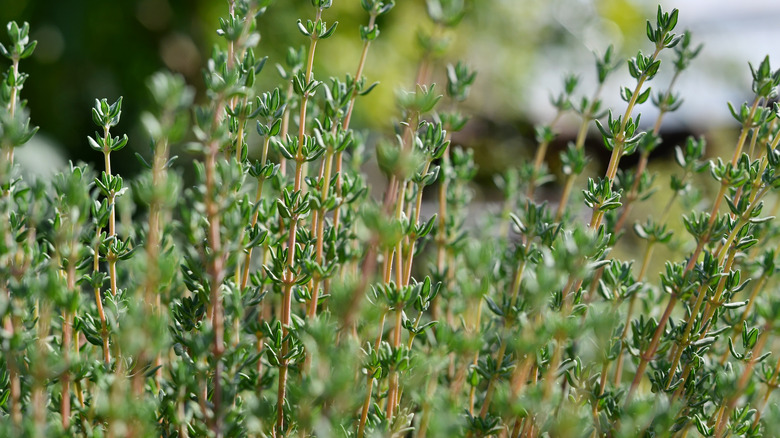Rachael Ray's Tip For Picking Out Fresh Thyme
Basil, cilantro, oregano, and rosemary may be your go-to herbs when you are cooking, but they aren't the only flavor enhancers you should be reaching for in your culinary arsenal. A member of the mint family, thyme is wonderfully fragrant and works well in a number of recipes whether it be a marinade for your lamb chops or sauce for your favorite pasta dish. Thyme is also delicious in your Saturday night artisan cocktail or it can play a starring role when you bake your next loaf of bread.
Thyme is often described as pungent, having a sharp and spicy taste that is used in both Italian cooking and Mediterranean dishes. While most fresh herbs are typically added at the end of cooking a recipe, thyme is a hearty herb that actually needs a longer cook time to impart its taste on whatever you are conjuring up on your stovetop or in your oven. Of course, thyme is also a bit of a time suck when it comes to removing those little herby green leaves from the stems that hold them. However, there's always a solution to life's cooking conundrums and luckily, Rachael Ray explains what you should look for when using fresh thyme to make this task a little easier.
Check out those stems
In a question session on her site with her hubby, John Cusimano, Ray was asked if there is an easy way to separate those little leaves from the stems. The celebrity chef revealed the easiest way to get enough thyme to use in your recipes is to look at the stems before you purchase the herb. "You hold it at the top and just pull gently backwards — [but] it depends on how tough the stems are," Ray explained. "So, I don't know if you grow thyme and have a little garden, or if you're buying it in the grocery store, but you want a stem that looks a little thicker and tougher, actually, because the leaves are more developed and it will be easier to strip them back."
However, if you are using lemon thyme, the cooking host concedes this can be a trickier process because the stems tend to be soft, making it a little more difficult to quickly accomplish your task. While Ray is an advocate for using the fresh version of this herb, she also said opting for the dried version to save yourself the frustration and hassle is completely acceptable. Using dried spices can also be better if you're cooking a dish for a longer amount of time, as its flavor won't dissipate as quickly. But if you're looking to try out this hack and for a way to incorporate this culinary ingredient into your next meal, try our bone-in rib eye with rosemary, garlic, and thyme recipe.

